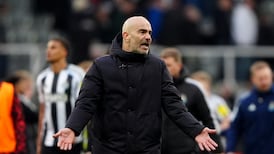This course has offered an examination that is tough but fair, just as the USPGA planned for with an eerie accuracy, writes PHILIP REID,Golf Correspondent, in San Francisco
ONCE BITTEN, twice shy. A year on from Rory McIlroy’s record-breaking performance at Congressional – when the Ulster man smashed record-after-record, with rather greater effect than Sergio Garcia managed in attempting to pummel a tee-side television microphone – the US Open at the Olympic Club returned to its old self: a grind, a course on which plodders rather than swashbucklers hold sway.
For this one, the USGA got their way; and they got it right. Perhaps last year was a freak of nature. On a couple of counts: firstly, the heavy rains in the run-up to last year’s championship softened the courts to such an extent that the driver became the club of choice off the tee and the greens proved receptive; and, secondly, McIlroy had the tournament of his young life. He could do nothing wrong, and did everything right.
The Olympic Club was never going to witness such a spellbinding display of low scoring. For the record, McIlroy’s haul of new records included those for low-36 holes (131), low-54 holes (199), low-72 holes (268) in the US Open. He also won with the lowest score under par (-16) and became just the third player in US Open history (joining Lee Trevino in 1968 and Lee Janzen in 1993) to shoot four sub-70 rounds.
Although Graeme McDowell and Jim Furyk reached the 54-hole stage under par, it was only by one shot.
And it was just the second time since Tiger Woods at Pebble Beach in 2000 that the 54-hole leader was on par or better (McIlroy last year).
That G-Mac and Furyk sneaked in below the par mark was pretty much what the USGA planned for, with an accuracy that bordered on eeriness.
Their plan is to have the winning score around par. For the most part, the examination at Olympic was tough but fair. It most definitely wasn’t like the birdie blitz of a year ago, a most untypical USGA result. It wasn’t ever going to happen again. As far as the USGA are concerned, lightning doesn’t strike twice on their turf.
There is a tradition within the USGA to make the US Open courses something of a stress test for participants, even if that means that par is a good and sometimes great score. As Tom O’Toole, the chairman of the USGA championship committee, put it the other day: “The concept of trying to test the greatest players in the world might not be particularly spectator-oriented to some people. But this has long been a brand of the USGA to be golf’s toughest test and require players to use both mental and physical capabilities.
And USGA president Mike Davis, responsible for he course set-up, made the point that the US Open wouldn’t really be the US Open if half the field were under par. “I think if fans had to see this [type of golf] 52 weeks of the year, it wouldn’t be good. But to see it once a year, well, at least the feedback we’ve gotten for decades and decades tells us it’s something fans want to see. They want to see a tough test, one week of the year.
“The trick is we want to make it hard, but there needs to be an exciting part of it too. That really is the trick. I think it’s possible to do both. So what we really strive to do is make it a difficult test, but make it interesting.”
The scoring at the Olympic club indicated that the USGA ticked virtually all of the right boxes in terms of getting a fair but tough examination and a results table at the end of each day that showed players could, if they hit the right shots in the right places at the right time, score. And they were punished if any shots were mishit. It can often be a thin line, but it worked here . . . and the general consensus among players was of a tough but fair course, albeit one, as Graeme McDowell put it, that rewarded those who plodded along.
As Ernie Els acknowledged, “the course is really difficult . . . but there’s a bit of moisture that [helps] and guys that are really on their games can shine a bit”.
An example of the balance that the USGA sought to give over the championship was demonstrated by the par five 16th. At 671 yards, the hole was the longest in the history of the US Open: for the first round, it played to 660 yards (a slog); for round two, it was reduced to a mere 609 yards, and for round three it was brought back to its full length of 671 yards. In the give and take nature of the exam, though, it was brought forward to 569 yards for yesterday’s final round.
The set-up is down to Davis. As O’Toole remarked of the USGA executive, “Mike’s strength is obvious. He’s got a great talent and vision to be able to set a golf course up that can test the greatest players in the world with some intrigue and creative. He’s brought some real intrigue and creativity and it really requires a player to use their mental capabilities along with their physical capabilities to get their way around the setup”.
Davis, for his part, accumulates pages of notes from each venue. “I always go away from a championship, and particularly if I think I’m going to come back to that course or just for somebody that might come back in the future, where I will make pages of notes of things I would have done differently.”
All with the aim of ensuring that the US Open remains the toughest examination of any given golfing year.











